Hawaiian volcanoes - Part 6: Mythology vs Geology
You cannot talk about the geology of Hawaiian volcanoes without mentioning the mythological beliefs the ancient settlers of Hawai’i used to explain the world around them. The myths involving the deities involved in the Hawaiian mythology are extensive. My reading has only touched the surface and I want to concentrate in this comparison solely on the stories that surround the Formation and the Life cycle of Hawaiian volcanoes, so we can compare it with the lessons learned from my previous posts.
The mythological beliefs of the Hawaiian people for the formation of their home show remarkable similarities with the modern explanation by plate tectonics.
The myths start with the birth of Pele. Similar to the working geological processes, Pele was born as molten lava from her mother, Haumea, who personifies the Earth. Her father was Kū, who is referred to as the ‘man-eater’. He represented the destructive forces of nature. Pele and her sister, Nā-maka-o-Kahaʻi, were born on an island in the South Pacific and were always at conflict, just as fire and water are two opposing forces. To escape this rivalry among siblings, Pele sailed away in a great canoe given to her by her brother Ka-moho-aliʻi, the shark god. Nā-maka-o-Kahaʻi went onto another island and settled on a high peak, where she could command the seas.
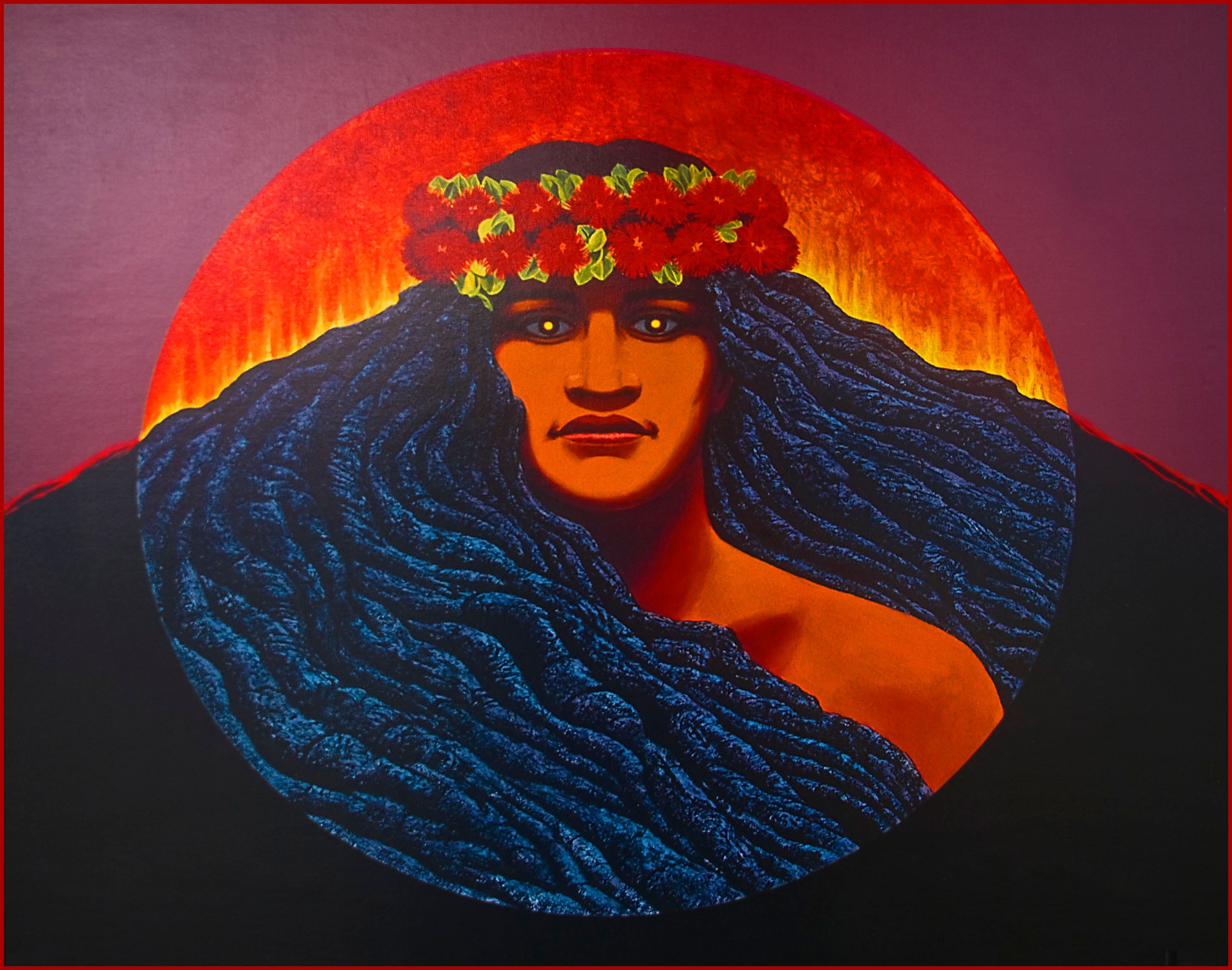
Drawing of the Goddess Pele.
flickr.com
Pele posseses a magic digging tool, the fire stick Pa’oa. Wherever she landed she used the Pa’oa to dig down deep into the crust of the ear and draw up the living lava below. The erupting lava opened a volcanic crater where she could live. The first volcanoes Pele created were close to the sea at the flanks of mountains. There they were under constant attack from waves send by Nā-maka-o-Kahaʻi.
Eventually Pele went to Niihau, the Hawaiian island that lies furthest to the northwest. But Nā-maka-o-Kahaʻi kept attacking Pele wherever she went. This forced her to move eastward to the neighbouring island Kauai, where she again dug a deep fire pit. Relentless attacks by her sister forces Pele to abandon this new volcano as well and continue to move further eastwards, onto Oahu. But this crater got also drowned by her sister’s salty waters.
On her way southeastward Pele visited many islands that were continuously destroyed by her sister. Either actively by sending waves, or indirectly. In some cases, Pele used her fire stick Pa’oa and dug too deep where she inevitably hit water that extinguished her flames.
This interaction between volcanoes and water described remarkably well the events that were happening. The eroded remains of ancient volcanoes along the Hawaiian Ridge show interaction between groundwater or perhaps seawater, which penetrated into the magma chamber, flashed to steam, and created an explosive eruption.
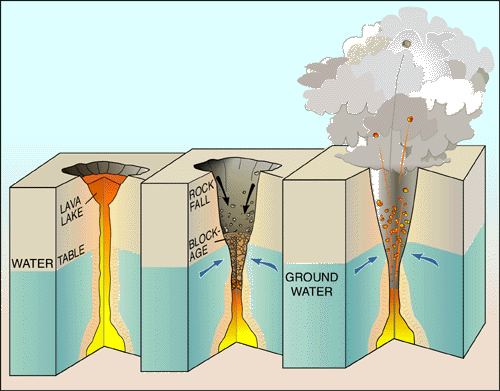
Sketch showing the cause for explosive Eruptions in Hawaiian volcanoes.
pubs.usgs.gov
When Pele arrived on the island of Maui she climbed on top of the mountain and created an enormous crater. This crater is known today as Haleakalā. Here Nā-maka-o-Kahaʻi decided to battle her sister directly. During a raging fight she tore Pele apart and scattered her bones along the shore. There they formed irregular masses of lava, called Naiwi o Pele, or Pele’s bones. After her victory, Nā-maka-o-Kahaʻi celebrated and returned to her remote island. But when she looked back to the Mauna Loa on the island of Hawaii, she saw red-hot smoke emerging from the crater, in which she saw Pele’s spirit. At this point Nā-maka-o-Kahaʻi realized that she could never completely defeat her sister and settled by continuously attacking Pele’s creations with her fierce waves.
The Hawaiian mythology shows the path of Pele towards the east along the Hawaiian Ridge and corresponds perfectly with the movement of the Pacific plate across the hotspot, continuously creating new islands. And the stories of Nā-maka-o-Kahaʻis wrath against her sister show a clear understanding of the erosional processes through which new islands become old and eventually disappear beneath the ocean.
Before Pele arrived on Hawaii, the island was inhabited by another fire god, Ai-laau. His name means ‘the forest devour’ and refers to the lava flows that regularly ‘ate’ their way through the islands forests. He fled when he saw Pele coming and left the island to her. Despite their destructive forces, the fire gods were always viewed with duality. When the lava flows weather, they create soils incredibly rich in nutrients. On this soil new vegetation could flourish. Therefore the gods were both feared and respected.
When Pele arrived at Mauna Loa, she found that this place fulfilled all her desires and she fastened herself tight to Hawai’i for all time. Today she resides in the Halemaumau crater, a crater within the summit caldera of Kīlauea, which arises from Mauna Loa.
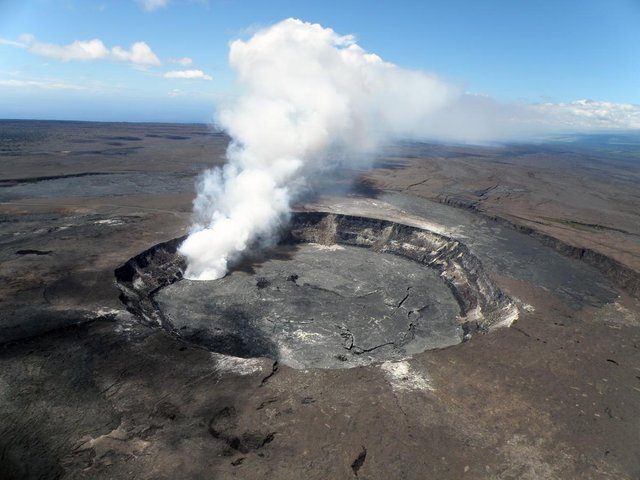
Halema'uma'u crater.
en.wikipedia.org
Today we know that Mauna Loa and Kīlauea are fed from seperate plumbing systems and represent individual mountains. With 1,247 m above sea level, Kīlauea is 3,000 meters shorter than Mauna Loa. Yet it is a huge mountain. The crater is currently active and constantly varies in size. At the moment it is around 800 m wide. In the past Halemaumau contained a lake of molten lava. In 1924 a flank eruption allowed water to enter the system resulting in an explosive eruption. Now the floor of the crater is made up of grey, hardened lava. The red fires of Halemaumau can now only be observed during eruptions.
Current eruption on the Big Island of Hawaii often appear in fountains. These fountains throw catapult pieces of lava into the air where they quickly cool to volcanic glass. Because of their trajectory through the air they develop characteristic shapes with the round front and a little tail.
These small glass fragments are called Pele’s tears by the Hawaiian locals.
If thrown out lava bits get caught by high winds they stretch into long, fine strings of glass and collect on the flanks of the volcano.
The Hawaiians call these clusters of the spun glass threads Pele’s hair.

Tephra falling form a lava fountain.
volcanoes.usgs.org
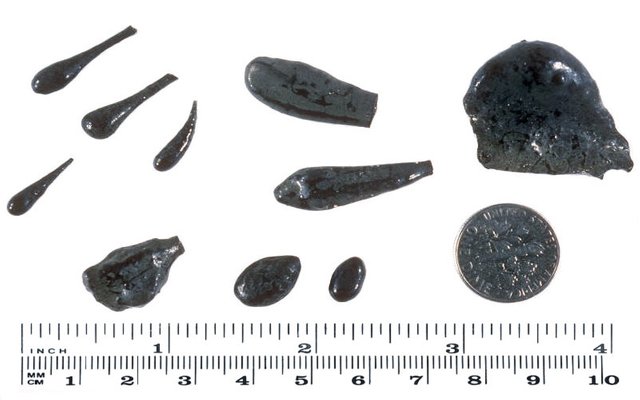
Assorted shapes of Pele’s tears from Maua Ulu. US dime for scale.
wikepedia.org
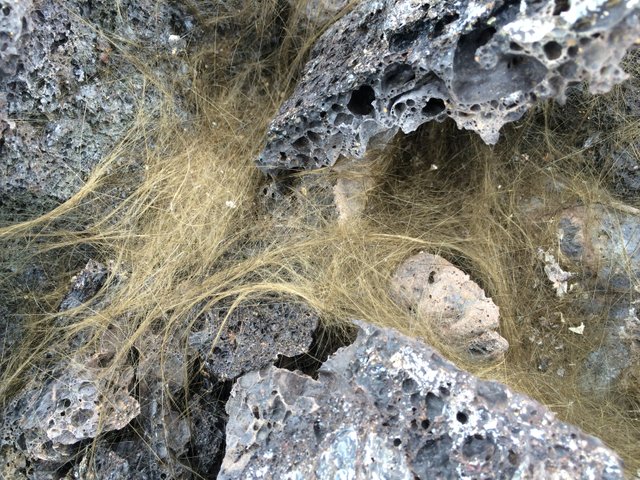
Greenish-gold strands of Pele’s hair.
commons.wikimeida.org
Previous Posts
Hawaiian volcanoes - Part 1: Introduction
Hawaiian volcanoes - Part 2: The Hawaiian Hotspot
Hawaiian volcanoes - Part 3: A growing volcano
Hawaiian volcanoes - Part 4: The Rejuvenation Stage
Hawaiian volcanoes - Part 5: Evolution to Atolls and Seamounts
Sources
http://fireofthegoddess.com/peles-paoa-the-power-of-the-fire-stick/
https://www.flickr.com/photos/22711505@N05/16528063216
http://www.geo.tu-freiberg.de/Hauptseminar/2009/Diana_Oettel.pdf
https://pubs.usgs.gov/fs/fs132-98/
https://volcanoes.usgs.gov/vsc/glossary/lava_fountain.html
https://en.wikipedia.org/wiki/Haleakal%C4%81
https://en.wikipedia.org/wiki/Halemaumau_Crater
https://en.wikipedia.org/wiki/Pele_(deity)
https://en.wikipedia.org/wiki/Pele%27s_hair
https://en.wikipedia.org/wiki/Pele%27s_tears
Zeilinga de Boer, J. and Sanders, D.T., (2002). Volcanoes in Human History: The Far-reaching Effects of Major Eruptions. Princeton University Press
You received a 80.0% upvote since you are a member of geopolis and wrote in the category of "geopolis".
To read more about us and what we do, click here.
https://steemit.com/geopolis/@geopolis/geopolis-the-community-for-global-sciences-update-4
An informative article..! 👌
Didn't know much about this mythological background of these volcano..!!
As a general reader of ur post,
one small suggestion came out to my mind is that u should care a little more about the formatting of the article. Ur citations are quite good but excessive use of italic characters might not be a pleasant experience for the readers...
Best regards...! 😊
Thank you for your suggestions.
I usually do not use extensive italic, but I was trying to optically seperate the mythology parts (normal) and the geology parts (italic).
Do you have an idea how I could achieve that in a more optically pleasing way?
u may use different headings for each part of ur article, also can highlight the first sentence of each paragraph and type the rest in normal fornt.... that would make the paragraph separated from the previous one.
u may join our discord channel to get assistance in formatting ur post..!
a group of friendly and experienced 'Mentors' will guide u towards a perfectly constructed article...!
have a good day..! 🤗
I like the "formatting the first sentence of the paragraph different' idea. Will definitely use that the next time I make a post like this.
Thank you :)
Best wishes..! 🙌
@sooflauschig you're probably busy but is there any chance you might be able to identify some stones I have?
I am not good with photo identification but we can definitely give it a try :)
In New Zealand we have Maori legends about our volcanoes which are very similar. Pele’s hair is really amazing, would have never guessed that was made of a lava.
Yeah, it's crazy. Because of it's glassy nature and small size it is quiet dangerous and can lead to lung and eye irritations.
Volcanoes can never just be pretty -.-
You just planted 0.22 tree(s)!
Thanks to @sooflauschig
We have planted already 3183.31 trees
out of 1,000,000
Let's save and restore Abongphen Highland Forest
in Cameroonian village Kedjom-Keku!
Plant trees with @treeplanter and get paid for it!
My Steem Power = 18547.01
Thanks a lot!
@martin.mikes coordinator of @kedjom-keku